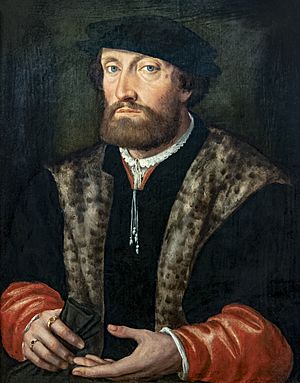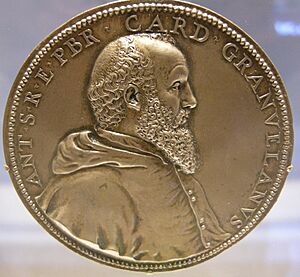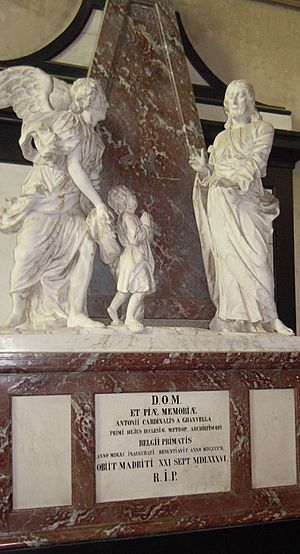Antoine Perrenot de Granvelle facts for kids
Quick facts for kids His Eminence Antoine Perrenot de GranvelleCount of La Baume Saint-Amour |
|
|---|---|
| Cardinal, Archbishop of Besançon | |

Portrait by Willem Key
|
|
| Archdiocese | Besançon |
| Appointed | 25 June 1584 |
| Reign ended | 21 September 1586 |
| Other posts | Cardinal-Bishop of Sabina (1578-1586) |
| Orders | |
| Ordination | 1540 |
| Consecration | 21 May 1542 by Juan Pardo de Tavera |
| Created Cardinal | 26 February 1561 |
| Rank | Cardinal-Bishop |
| Personal details | |
| Born | 20 August 1517 Ornans, Besançon, Holy Roman Empire |
| Died | 21 September 1586 (aged 69) Madrid, Kingdom of Spain |
| Previous post | Archbishop of Mechelen (1561-1583) Bishop of Arras (1538-1561) |
| Motto | Durate |
| Signature | |
| Coat of arms | |
Antoine Perrenot de Granvelle (born August 20, 1517 – died September 21, 1586) was an important leader and diplomat from Besançon. He became a cardinal in the Catholic Church. Antoine followed in his father's footsteps, becoming a top advisor to the Spanish Habsburg rulers. He was one of the most powerful politicians in Europe during a time when Protestantism was becoming popular. People even called him "the most important Imperial statesman of the whole century."
Antoine was also a famous art collector. He was known as "the greatest private collector of his time." He was a friend and supporter of famous artists like Titian and Leone Leoni.
Contents
Life Story
Antoine Perrenot de Granvelle was born in the Free Imperial City of Besançon. This city is now part of France. Back then, it was a self-governing city. It was surrounded by land that belonged to the Holy Roman Empire.
Early Life and Education
Antoine's father, Nicholas Perrenot de Granvelle, was a very important person. He became the chancellor, or chief minister, for Charles V, Holy Roman Emperor. His father was a trusted advisor to the emperor from 1530 until he died.
Antoine studied law at Padua and religion at Leuven. After finishing his studies, he became a canon in Besançon. A canon is a type of priest.
Becoming a Bishop
In 1540, when Antoine was only 23, he became the bishopric of Arras. This was a special permission because he was so young. He was ordained as a priest in the same year.
As a bishop, Antoine went to many important meetings. These included meetings of the empire and the first sessions of the Council of Trent. He spoke for Emperor Charles V at these meetings. Because his father was so powerful, Antoine was given many difficult tasks.
Diplomat and Advisor
Antoine became very good at diplomacy, which is the art of dealing with other countries. He learned a lot about European politics. He helped settle the peace after the Schmalkaldic League was defeated in the Battle of Mühlberg in 1547.
In 1550, Antoine took over his father's job as secretary of state. He was with Emperor Charles V during a war with Maurice of Saxony. He also helped write the Peace of Passau agreement in 1552.
The next year, Antoine helped arrange the marriage between Queen Mary I of England and Philip II of Spain. When Emperor Charles V stepped down in 1555, Antoine started working for Philip II. Philip then sent him to the Netherlands.
Work in the Netherlands
In 1559, Antoine helped sign the Treaty of Cateau-Cambrésis. This was an important peace treaty. When King Philip left the Netherlands, Antoine was secretly made the chief advisor to Margaret of Parma. She was the regent, meaning she ruled the Netherlands for the king.
Antoine's strict policies in the Netherlands made many people unhappy. But he was rewarded for his work. In 1560, he became the archbishop of Mechelen. In 1561, he became a cardinal. However, people in the Netherlands did not like his religious policies. So, in 1564, he moved to Franche-Comté on the king's advice.
Later Career and Death
After visiting Rome in 1565, Antoine was appointed to an important group by Pope Pius V. This group handled the foreign policy of the Papal States.
In 1570, King Philip asked Antoine to help create an alliance. This alliance was between the Pope, Venice, and Spain against the Turks. This alliance led to the victory at the Battle of Lepanto the next year.
In the same year, Antoine became the viceroy of Naples. This was a difficult and dangerous job, but he did it well for five years. In 1575, King Philip II called him to Madrid. There, Antoine became the president of the council for Italian affairs.
In his later years, Antoine handled more important negotiations. In 1580, he helped join the kingdoms of Spain and Portugal. In 1584, he helped arrange the marriage of the Spanish princess Catherine to Charles Emmanuel I of Savoy. This marriage helped to limit France's power.
In 1584, he also became the archbishop of Besançon. But he became very sick and never officially took his place. He died in Madrid in 1586. His body was taken to Besançon Cathedral, where his father was buried. He is also remembered at Saint Rumbold's Cathedral, Mechelen.
Art Collector
Antoine de Granvelle had a very famous art collection. It included works by artists favored by the Habsburg rulers, like Titian and Leone Leoni. He also had several paintings by Pieter Bruegel the Elder. Many pieces were inherited from his father.
Jacques Jonghelinck, a sculptor and friend of Bruegel, had a studio in Granvelle's palace in Brussels. While in the Netherlands, Granvelle "discovered" the artist Antonis Mor. He introduced Mor to the Spanish court. Granvelle also supported Giambologna and helped him make his first trip to Italy.
When Granvelle died, his art collection went to his nephew. However, Rudolf II, the Austrian Habsburg Emperor, wanted the best pieces. He pressured the nephew to sell them. In 1597, the nephew reluctantly sold 33 works. He complained that the price was too low, not even enough for six pieces. He had even turned down more money from Cardinal Farnese for just one painting by Dürer.
Most of these artworks are now in Vienna or Madrid. They include Titian's Venus with an Organ-player, a copy of the equestrian statue of Marcus Aurelius by Giambologna, and tapestries based on drawings by Hieronymus Bosch. There is also a bust of Charles V by Leoni.
Antoine de Granvelle was painted by Titian and Mor. But one of the most famous portraits connected to him is by Mor. It shows Granvelle's dwarf and his dog. This painting is now in the Musée du Louvre. It might have started the Spanish tradition of painting court dwarfs.
Justus Lipsius, a Flemish scholar, worked as Granvelle's secretary in Rome for a time. Granvelle also wrote letters to composers like Lassus and Adrian Willaert. He had a magnificent library, and some of his books are still in Besançon today.
See also
 In Spanish: Antonio Perrenot de Granvela para niños
In Spanish: Antonio Perrenot de Granvela para niños




